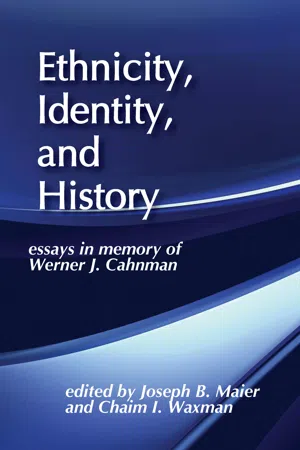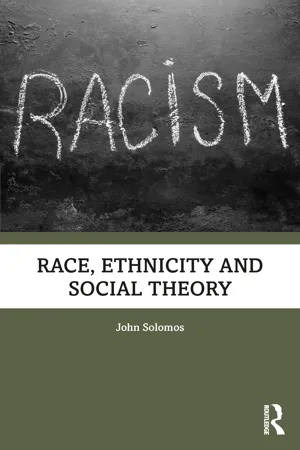History
Race Relations
Race relations refer to the interactions and dynamics between different racial groups within a society. This includes the ways in which people from different racial backgrounds perceive and interact with each other, as well as the social, economic, and political implications of these interactions. Throughout history, race relations have been marked by inequality, discrimination, and efforts to address and overcome these challenges.
Written by Perlego with AI-assistance
Related key terms
1 of 5
4 Key excerpts on "Race Relations"
- eBook - ePub
Ethnicity, Identity, and History
Essays in Memory of Werner J. Cahnman
- Joseph B. Maier(Author)
- 2017(Publication Date)
- Routledge(Publisher)
We have come quite a distance from the statement that Race Relations are relations between people(s) who are physically distinguishable. Instead of an emphasis on biology, a more appropriate definition is one which stresses sociocultural aspects. A usable definition of Race Relations emphasizes relations not race because, in the final analysis, rather than race causing relations it is the relational context that makes for “race.”A useful working definition of Race Relations would be something like the following: Race Relations refers to those relations between (or among) peoples wherein the interaction and institutional arrangements are rationalized by shared beliefs and judgments concerning the essential, i.e., innate, characteristics of the depressed group (i.e., “race”) and the oppressing group (i.e., “race”). It is important to understand that the more powerful group, the members of which fill the controlling positions in the major organizations of the social system, defines the “innate” characteristics of the less powerful, the depressed, group as well as the traits of its own group.8In such a situation the presence of some readily recognizable characteristic helps in drawing the line between the superior (i.e., more powerful) and the inferior (i.e., the suppressed) group. If physical differences characterize two unequal (in power) groups and if these are viewed as significant signs of imputed biological differences, we have a situation of Race Relations! If, in a situation of superordinate/subordinate relations, no such physical characteristic differences exist, they may be created! An example of this was the designation of Jewish Germans as an inferior “race” by the German government during the Hitler regime and the legal requirement that Jewish Germans (otherwise largely indistinguishable on a physical basis from other Germans) wear a six-pointed yellow star on their outer garments in order to render them distinguishable.The notion of the overriding importance of biological characteristics — rather than relational structures — in the development of Race Relations does not die easily. Only an examination of the evidence will be convincing. - eBook - PDF
An Introduction to Immigrant Incorporation Studies
European Perspectives
- Jan Rath, Marco Martiniello, Marco Martiniello, Jan Rath(Authors)
- 2014(Publication Date)
- Amsterdam University Press(Publisher)
Race, racism and social relations A key area of debate that has emerged as a result of the trends outlined above is the analytical relationship between race, racism and ethnicity and wider social and economic structures. In some contexts this has been framed more narrowly around the issue of the relationship between race and class. Whether from a neo-Marxist or Weberian perspective, the rela-tionship between race and class is a recurring theme in sociological analy-sis, as reflected in the work of Robert Miles and John Rex among other scholars (Miles & Brown 2003; Rex 1981). Preoccupation during the past decade with the phenomenon of ‘white working-class racism’ can be taken as an example of the enduring influence of these concerns in the current social and political environment. Seeking to understand these phenomena means being clear about what is subsumed under terms such as race and racism. One key question that Going global 98 John Solomos has shaped contemporary discussions is the following: How has the cat-egory of race come to play such an important role in moulding contem-porary social relations? This is not to say that there is agreement about how best to answer this question. On the contrary, scholars and research-ers show little sign of agreeing even about the meaning of notions such as race, racism, ethnicity and related social categories (Winant 2006). Many of the questions raised in these debates raise doubts on whether race is a suitable category for social analysis. What do we mean when we talk of race, racism or ethnicity as shaping the structure of particular societies? What role have race and ethnicity played in different historical contexts? Is it possible to speak of racism in the singular, or should “racisms” always be in the plural? These questions are at the heart of many of the theoretical and conceptual debates that dominate current research agendas. - eBook - PDF
- Ronan Paddison(Author)
- 2000(Publication Date)
- SAGE Publications Ltd(Publisher)
Events that may influence such shifts may involve black immigration, black movement into predominantly white areas, changes in the structure of the economy resulting in white insecurity, and black competition for white-held jobs. Such changes threaten the nature of Race Relations. The core of Race Relations in cities of Britain and the USA has been and continues to be that of inequality between whites and people of colour. Thus, changes which may result in reducing racial inequality or threatening the extent of white control or demographic dominance often lead to a shift in the percentage of supporters for maintaining white supremacy. 11 Race Relations in the City JOE T. DARDEN Among the changes in cities of Britain and the USA which have shaped Race Relations are inter-national immigration and internal migration of people of colour. To maintain white supremacy, such movement of people of colour has been controlled by immigration policies, racial segre-gation and discrimination in the housing and labour markets in each country. It is the belief in white supremacy and the extent to which it is acted upon in policy and/or practice that has shaped the nature of racial conflict in the cities examined in this chapter. When the belief is strong and widespread, it results in policies and/or practices that deny equal access to jobs and housing and other amenities to people of colour. Such denial of equal access based on race results in observable racial inequality. Through policies and practices, whites are advantaged and people of colour are disad-vantaged. Such inequalities along racial lines are observable in cities through examination of the quality of life of racial groups. Thus, underlying most racial conflicts in cities examined in this chapter is the factor of racial inequality, which is perpetuated by the dominant group. This chapter will demonstrate how such behaviour impacts on racial minority groups and their responses to such behaviour. - eBook - ePub
- John Solomos(Author)
- 2022(Publication Date)
- Routledge(Publisher)
There is a need to develop a model for conceptualising racism which is (i) sensitive to local and contextual manifestations of racist discourse and (ii) able to connect local manifestations with wider or national public discourses. Yet theoretical debates have produced accounts of racism which derive contemporary forms of racism from public political discourse. This evidence is then used to generalise broad trends within society. We are suggesting that there is a need to move away from this rather generalised approach and to situate racisms within settings and social contexts before moving towards a more general account of their wider significance. This is the approach we have adopted in this book, and our main concern is to analyse the ways in which specific racisms are situated social and political contexts.We shall argue that the analysis of contemporary racism needs to be situated within discursive contexts. Racism cannot be reduced to economic or class relations, but neither can it be seen as completely autonomous from wider social relations such as gender and sexuality. Therefore, there is a need for a more rigorous analysis of the interactions between racism and social, economic, political, and cultural relations. The implications of this analytic framework will be explored further in the rest of this volume. This will take us to the concluding chapter, where we shall again take up the question of how we can conceptualise the changing usages of race and racism in the present political environment.Racism and society
The emergence of critical and radical agendas in the period of the 1980s and 1990s did much to broaden the range of issues that were being analysed under the rubric of race and ethnic studies. At one level, this became evident in the growing bodies of scholarship about various facets of the sociology and politics of race and racism in British society. Growing literatures on political mobilisation and social change (Givens and Maxwell 2012 ; Perry 2014 ; Shukra 1998 ; Solomos and Back 1995 ), forms of social and cultural mobilisation (Keith 2005; Meer 2010 ; Waters 2019 ), and the evolution of urban multicultures (Nayak 2003 ; Neal, Bennett, Cochrane and Mohan 2018
Index pages curate the most relevant extracts from our library of academic textbooks. They’ve been created using an in-house natural language model (NLM), each adding context and meaning to key research topics.



